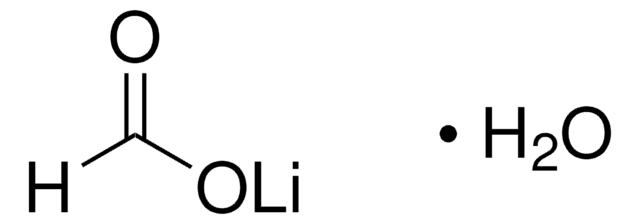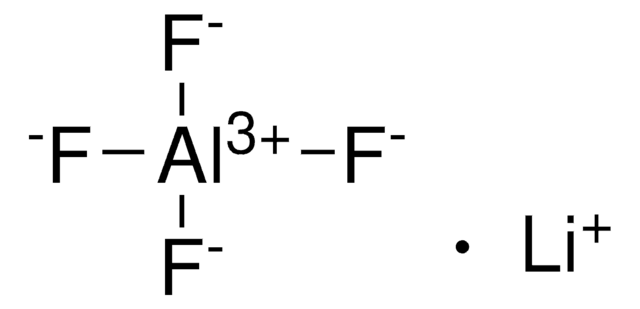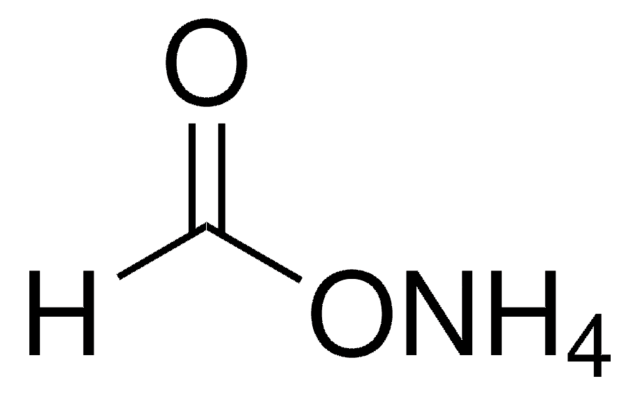433764
Cesium formate
98%
Synonym(s):
Formic acid cesium salt
Sign Into View Organizational & Contract Pricing
All Photos(1)
About This Item
Linear Formula:
HCOOCs
CAS Number:
Molecular Weight:
177.92
Beilstein:
3912426
EC Number:
MDL number:
UNSPSC Code:
12352302
PubChem Substance ID:
NACRES:
NA.23
Recommended Products
Assay
98%
form
crystals and lumps
SMILES string
[Cs+].[H]C([O-])=O
InChI
1S/CH2O2.Cs/c2-1-3;/h1H,(H,2,3);/q;+1/p-1
InChI key
ATZQZZAXOPPAAQ-UHFFFAOYSA-M
Looking for similar products? Visit Product Comparison Guide
Signal Word
Warning
Hazard Statements
Precautionary Statements
Hazard Classifications
Acute Tox. 4 Oral - Eye Irrit. 2 - STOT RE 2 Oral - STOT SE 2 Oral
Target Organs
Nervous system, Nervous system,Blood
Storage Class Code
13 - Non Combustible Solids
WGK
WGK 3
Flash Point(F)
Not applicable
Flash Point(C)
Not applicable
Personal Protective Equipment
dust mask type N95 (US), Eyeshields, Gloves
Choose from one of the most recent versions:
Already Own This Product?
Find documentation for the products that you have recently purchased in the Document Library.
Customers Also Viewed
Kyle C Costa et al.
Journal of bacteriology, 195(7), 1456-1462 (2013-01-22)
Hydrogenotrophic methanogenic Archaea are defined by an H2 requirement for growth. Despite this requirement, many hydrogenotrophs are also capable of growth with formate as an electron donor for methanogenesis. While certain responses of these organisms to hydrogen availability have been
R Blank et al.
Journal of animal science, 90 Suppl 4, 212-214 (2013-02-13)
Two studies, arranged according to a 4 × 4 Latin square design, were conducted to assess effects of dietary acidification on fungal 3-phytase (PHY) efficacy in growing pigs. In Exp. 1, effects of supplementing 500 units/kg feed of PHY and
Scott D Hamilton-Brehm et al.
Extremophiles : life under extreme conditions, 17(2), 251-263 (2013-01-25)
A novel sulfate-reducing bacterium designated OPF15(T) was isolated from Obsidian Pool, Yellowstone National Park, Wyoming. The phylogeny of 16S rRNA and functional genes (dsrAB) placed the organism within the family Thermodesulfobacteriaceae. The organism displayed hyperthermophilic temperature requirements for growth with
Cláudia Freitas et al.
Applied biochemistry and biotechnology, 169(7), 2038-2048 (2013-01-30)
The use of lignocellulosic materials as substrate for bioethanol production is considered a cost-effective approach to make the biofuel production process economically sustainable. However, lignocellulosic hydrolysis releases toxic compounds such as weak acids which inhibit microorganism growth and ethanol production.
Kyle C Costa et al.
mBio, 4(2), doi:10-doi:10 (2013-02-28)
Hydrogenotrophic methanogenic Archaea require reduced ferredoxin as an anaplerotic source of electrons for methanogenesis. H(2) oxidation by the hydrogenase Eha provides these electrons, consistent with an H(2) requirement for growth. Here we report the identification of alternative pathways of ferredoxin
Our team of scientists has experience in all areas of research including Life Science, Material Science, Chemical Synthesis, Chromatography, Analytical and many others.
Contact Technical Service














